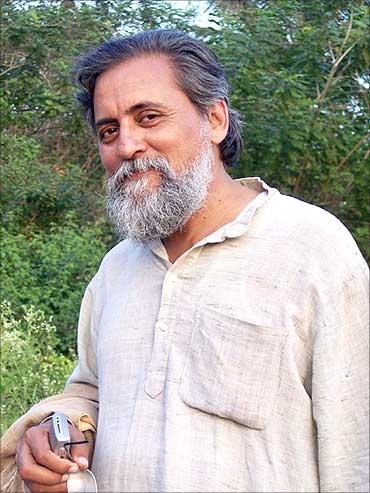
Although some of the innovations, like the powered-flour mill made a debut in the film 3 Idiots, a good majority of these brilliant ideas and products are yet to be recognised across the country.
Thanks to the relentless efforts of the National Innovation Foundation, under the guidance of Professor Anil K Gupta, these innovations are changing the stereotype perceptions of rural India, which is a picture of poverty and degradation.
In an interview with rediff.com, Anil Gupta, vice chairman and the brain behind NIF, says: "We have a culture that dubs innovation as craziness, but our success would lie in identifying more crazy people and their craziness so that the innovation revolution can spread across India."
With a database of about 140,000 innovations mostly from uneducated innovators, NIF has been striving for a decade to connect innovators with society and enterprise. The innovations address India's myriad problems, reduce drudgery and improve work efficiency, he says.
Besides being cost-effective and eco-friendly, these scientific discoveries have the potential to be commercialised and even exported.
Although some products are being commercially manufactured and have been exported, there are millions of ideas and innovators waiting for assistance in terms of funds, technical and design support.
Lamenting on India's regressive education system, he makes a significant observation. As a student he was not allowed to be creative.
"How long will we force our children to mug up books? When will our children wake up and realize their potential? Some of our children have made several innovations, which even multi-national companies (MNCs) have not been able to do," he points out.
Funds crunch, lack of adequate assistance from government officials and private sector firms, and lack of awareness among people have been the main deterrents in making this a national movement.
"There is a complete lack of interest from the scientific institutions of India to promote rural innovations," he says.
It was trip to Bangladesh in 1985 that changed him forever. He discovered that the landless farmers of Bangladesh were very creative and knowledgeable. When he came back he was paid in dollars for the consultancy work which involved documenting the poor people's knowledge and he realised that it was unfair he was getting paid for writing about their merits.
"The present generation is losing out on scientific knowledge. Never before in the history of human civilisation has so much of scientific knowledge been lost due to sheer neglect," says Gupta, who also dons the cap of a professor at IIM Ahmedabad.
Each and every village in India is blessed with real innovators and entrepreneurs. It is the duty of each and every citizen of this country to take a step forward to recognize their efforts and work collectively to make India a hotbed of innovation. Not only can these innovations make lives easier, they can build a resurgent, strong India on the basis of the knowledge and scientific know-how, he adds.
Even the international community has started looking at India as an innovative hotbed, which is promoting innovations by poor uneducated Indians, exemplifying the true spirit of India.
Gupta shares the excitement of discovering India's best innovators, nurturing them and making them the real heroes of India. His mission is to unleash the raw potential of more poor people, who are rich in knowledge and skills, in developing India as the innovative capital of the world. He dreams of an entrepreneurial revolution in India. Excerpts:
on India's successful innovations...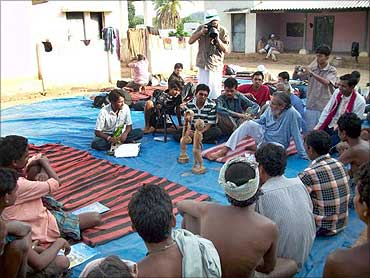
Working with innovators has been one of the most exciting things in my life. The rural innovators have the spirit to innovate and come up with solutions overcoming their problems.
Despite the lack of education, power and money, the grassroots innovations exemplify the struggle to find a better and cheaper solution to address our problems.
There is a lot to learn from their lives and achievements. It has been an enriching and enlightening experience. These tribals are the true pride of India.
They have so many great innovations. I found the villages in Bastar district to be one of the best in hygiene and sanitation. Here, a sick person is cremated after his death, while a healthy person who dies is buried. This is a good, healthy practice. Here is a lesson for all of us to follow.
The youth do not want to join Maoists, they are so talented that we should be able to guide them in the right direction. Unfortunately, the police and administration are indifferent to them. They are given no opportunity to exhibit their skills.
We are now initiating a programme to bring out their talent and make them leaders in their own right.
The government is not investing in places like this, there are not given any opportunity to come up in life. So their anger is not misplaced.
They have developed a medicinal variety of paddy. If we add such products to out nutraceuticals market, this will have such a huge impact. This agro-bio diversity should be catalogued and marketed. I have talks with the National Gene Bank but nothing has happened yet.
There are so many ideas that can drive the Indian economy. Our institutes should pay more attention in developing products that have mass appeal.

The NIF has a database of about 140,000 innovations. But there are many more innovators across India. Unfortunately, we are not able to reach as many people as we should.
Our constant efforts have been to work towards making these rural innovations the epithet of a developing India. We have succeeded to some extent in building a link with scientists and designers to add value to the innovators' technologies. We provide a micro venture innovation fund to convert innovations into enterprises and help protect heir intellectual property rights.
The basic idea is to promote creativity and innovation among people of all age groups. We also conduct competitions for school students. An encouraging aspect is the President rewarding our innovators every year.
This year President Pratibha Patil allowed us to hold an exhibition of the products at Rashtrapati Bhavan. This was a great gesture which no other head of state had done so far.
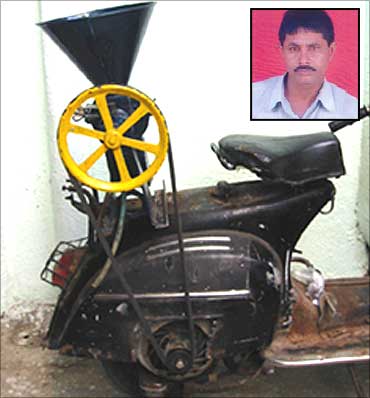
Innovation is not a common cultural trait in India. But we have found that India is rich in creative and talented people.
In India, there is a congenital failure to identify innovation and creativity. There should be complete change in parental and educational mindset to promote innovation and channelise the energy of our growing young population.
We need to rethink on multi-functionality, frugality, diversity and resilience, the four features of nature which should reflect in future designs for development and diversity.
The Honey Bee Network is working across countries struggling to bridge the gap between formal and informal technology. Our scientific organisations should acknowledge and recognise their talent and work in tandem to develop these innovations and make it to use in our daily lives.
...

Innovation is the only way to sustain India's growth. There are about 200 trouble-torn districts in India. Instead of declaring a war on them, their capabilities should be channelised in the right direction.
The youth of these places can be mentored to choose the right track and build a great society. India cannot take pride on a growth rate which is just benefiting 20 per cent of the total population. There should be an inclusive growth accommodating the entire society.
Many of these rural innovations can have a profound impact on our society.
Has any innovator have been approached by companies to manufacture his product commercially?
Around six companies have come forward to license products. T R Rajesh from Kerala developed a low-cost solution for sewage treatment which has been adopted by a company in Goa. It is a low-cost idea which can be easily implemented.
A company in Andhra Pradesh has paid an advance royalty to licence 6-7 herbal products of an innovator. They have put the photograph of the innovator on the labels.
We are in talks with TI Cycles. We have some brilliant ideas like the amphibious cycle, cycle-powered washing machine, etc.
Companies are now realising the need to harness low-cost technologies but this is happening at a very small scale. The aspirations of the corporate sector must change to accommodate our innovations.
...
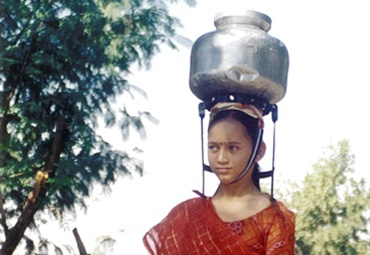
About 250 patents applications have been filed. In India, our innovators have got 35 patents and 5 patents in the United States.
The US patent office did not charge us any patent fee when they heard that the innovations were from people who had no formal training. In India, also we are charged less while applying for a patent.
However, getting a patent is a time consuming process. Considering the innovation at India's premier R&D institutes, NIF has a good record. The research at NIF is unparalleled. However, without value addition and conversion of these ideas into a larger entrepreneurial activity, there is no future.
We are also taking efforts to build the open source database where anyone can adopt these technologies in daily life or propagate them among the masses. We have 2000 such good ideas in the Honey Bee network.
We should have a fast track system for innovators. We also promote the format where any one can use the knowledge we have shared to build a product or a service.
The share of non-monetary technologies is less than 16 per cent in India. We invest so much in systems when there are low-cost solutions available.
...

Our volunteers go on a journey of discovery to remote areas across India. We conduct a Shodh Yatra every six months to reach out to the people. We have many students who volunteer to look out for innovators.
We have briefed them to look for the 3 I -- Interesting, Inspiring and Intriguing -- innovations.
There are thousands of ideas which are mainly at the conception stage. If there is more financial and technical assistance, these ideas can be developed to transform our society.
How does the NIF help entrepreneurs?
Once the innovations are identified, a trial and search is done to make sure this innovation is unique. Sometimes the product may be distinctive though it may be already in existence. It could be a modification of a product at a lower cost.
The proof of conception is also verified. At times, the innovation is not refined to become a product. So we get designers and fabricators to help them improve and develop the product. We assist them in product development and technical support.
If it is a herbal product, we have a tie-up with the Council of Scientific & Industrial Research and Indian Council of Medical Research to help in researching and validating the product.
Value addition is very important in scaling up the product. The patent right belongs to the innovator and NIF has no role in it.
...
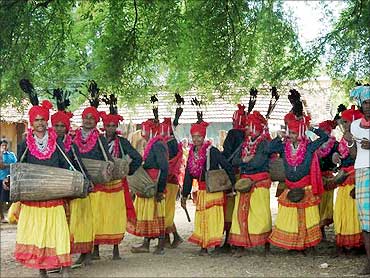
The Shodh Yatra (inquisitive tour) is basically a journey on foot to celebrate creativity at grassroots across the nation, every year. It is amazing to see so many ideas among the poor and tribals in India.
We walk every six months and during our journey, we meet many innovative people at the micro level in every area. So I am very confident that there are many more people across the nation with new ideas.
They need hand-holding and guidance to give a definite shape to their ideas. In the last 10 years, we have walked about 12,000 kms as a part the Shodh Yatra. In the Naxal-affected Bastar district, we met so many talented tribal people. The tribal people whom we ignore are rich in traditional knowledge and have impeccable artistic skills.
...

Do the national media, All India Radio and Doordarshan, have any programme to showcase India's innovative people?
How many media organisations come forward to spread the message that there is an awake India that can take on the world with the assistance of the government and private players?
There should be a combined and sustained effort. How many school text books have a chapter on innovations by any one of our innovators? Instead of teaching about pre-Independence heroes, we should revise our textbooks to teach relevant and intelligent ideas that can fuel innovation at a young age.
We should stop imitating and mimicking the West. Our techpedia initiative has a database of over 350,000 projects from college students which could be developed into products and useful services. We have made an attempt to map the minds of the our young and brilliant technologists.
What should the government do?
The government has neglected innovation. We spend crores (millions) on the National Rural Employment Guarantee Act (NREGA) to offer 250 million people employment for 100 days. This is a national shame as these poor people are forced to do menial jobs like digging the earth and breaking stones.
Besides this, the scheme is being run in the most developed states. Many among these workers are very creative -- there are artists, mechanics and sculptors among them. Should this be the right approach? They should be trained and promoted to exhibit their talent.
This great human resource should be made to work intelligently. About 99 per cent of them are very talented people. They should be given the freedom to develop their skills or take part in activities helping other entrepreneurs.
There are so many talented singers, dancer and actors who know the traditional art and dance forms. These can be aggregated into a rich database of art and culture and showcased online. This will not only preserve our rich cultural heritage but also help them financially.
There are several ways of promoting our talent.
...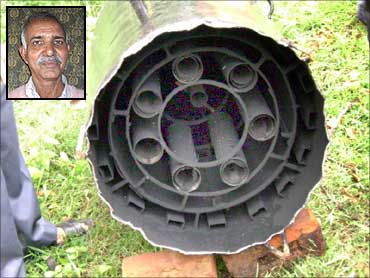
The pollution levels in Indian metros are rising. We have an entrepreneur who has found a solution to this alarming problem. A mechanic, he developed a device which absorbs carbon content from generators or engines of 10-12 HP. There are no generators in India that have a pollution control device attached to them. There is no requirement under the present rules.
However, Virendra Kumar Sinha from Bihar has made a pollution control device for gensets. This device absorbs exhaust gases making it clear, along with reducing its temperature. Why don't we use this in automobiles and small-scale industries? These are cleaner and cheaper alternatives.
He made this device as there was a school near his unit. He did not want the school children to be affected. If we had been a proactive society, the pollution control board should have approached us to make use of the device.
Every genuine manufacturer should implement these kinds of environment-friendly solutions. There should a huge demand for these indigenous products. There are a large number of ideas which are yet to be diffused at the scale they should have.
...

We have found the maximum number of innovations in Gujarat. This is also because we are based in Gujarat. Kerala, Bihar and Karnataka also have a good number of innovators. A good number of innovations have come from artisans, farmers, mechanics...and women.
Women have been very innovative. Since they have been traditionally not allowed to experiment, they have built products and solutions in food processing, childcare, etc. Despite the constraints, women have excelled. Women are very creative and talented but there are no opportunities to support their ideas.
A simple traditional medicine is rubbing nutmeg powder on the navel of babies. Many of the traditional ideas are easy to implement, and have no ill effects. But has our healthcare policy ever looked at these aspects?
Our children are losing out on traditional knowledge. There is no importance to values today. One of the reasons is a total disconnect between the grandparents and children.
How do the HoneyBee Network and SRISTI help NIF?
Honey Bee Network is a network spread across 75 countries of individuals, innovators, farmers, academicians, policy makers, entrepreneurs and non-governmental organisations who work with NIF in discovering and promoting poor people who are rich in knowledge and innovation.
SRISTI is a global initiative and an NGO, established in 1993 to network local innovators. It provides organisational support to the Honey Bee Network. All have the same goal of strengthening grassroots level innovators and inventors engaged in conserving biodiversity.
...

This initiative is towards building a global platform for our innovators. We are working closely with the China Innovation Network which has about 300 innovations.
China and India are the two major powers of the world today. The trend of aping the West should stop. The moment countries start putting curbs on immigration, it is clear where there are headed to.
Together, India and China can make a profound impact with our traditional knowledge and innovative spirit. India and China are at the centre of the world's attention today and this is the best time to capitalise on our strengths.
What are the challenges you face?
We face staff and fund shortage. We have a staff of only 40 people who work on a contract basis. They work hard despite so many constraints. I am very happy that we have such a wonderful team.
We do have many volunteers under the Honey Bee Network but this is not enough. We need to send this message to the masses. There is no mass acceptance yet. This has to change.
Movies like 3 Idiots did showcase some of our innovations. But that hasn't had the impact it should have had. Our agriculture farms should showcase the innovation of many of our farmers.
The devices they have built can be used across the country for better productivity. Tea plucking is a tedious job, but our innovators have found a simple solution to make this process easier.
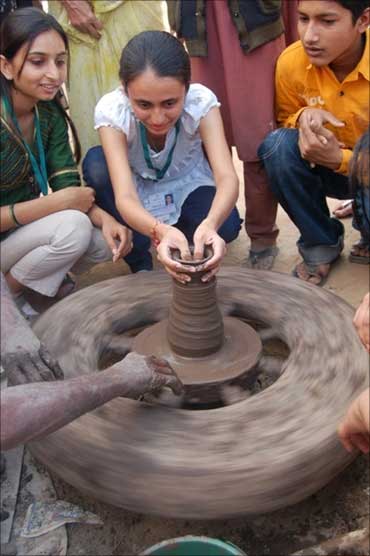
Many IITians have great ideas. Not just IITians, even local technical institutes have a wealth of ideas. But they don't get the required help or support in India. We cannot blame them for digressing to other fields.
In a government polytechnic college in Latur (in Maharashtra), three young girls have built a black box for automobiles. How many people in India know about this? Should not such products be developed and sold in a mass scale?
There is no acknowledgment from any quarter. These ITIs (Indian Technical Institutes) and polytechnics have mass talent at grassroots level. So, I think, the government needs to look into the development of these institutes if they want to promote rural population.
Are students from IIMs (Indian Institutes of Management) taking any interest in promoting entrepreneurship and promoting rural innovators?
Students from IIMs take part in conducting various activities for the rural innovators as a part of the curriculum. However, there has not been much progress in terms of adopting their ideas and promoting innovators.
An Indian School of Business (ISB) graduate has shown interest in some of our innovations and plans to promote it on a large scale.
...

The National Innovation Foundation was set up in March 2000 after we had several rounds of discussions with policy makers over a period of six months, convincing them of the need for such an establishment.
Dr R A Mashelkar's is the chairperson of NIF. Funds crunch is one of our biggest deterrents. It was set with a corpus fund of Rs 20 crore (Rs 200 million) when we actually needed Rs 200 crore (Rs 2 billion). However, the NIF will now be converted into a grant-in-aid institution under the Department of Science and Technology.
Hopefully, we will get more resources and assistance. The NREGA gets Rs 60,000 crore (Rs 600 billion) every year. We do not even get one per cent of this amount!
What is your advice to the young innovators/entrepreneurs?
We need to bring about an entrepreneurial revolution in India. The environment in India now is ideal to focus on new ideas and build enterprises for social development.
Youngsters should not be afraid of taking risks. There is no harm in attempting to develop your own idea or supporting a unique initiative. Even if you do not succeed, you can go back and take up any job.
Technology and business have developed at a fast pace. So there is a huge scope for nation building if youngsters come forward to promote unique initiatives that are rooted to our culture and people.
These can have a transformational effect in developing India as a leader in sustainable technologies. It is very essential to think differently and have an identity of your own.